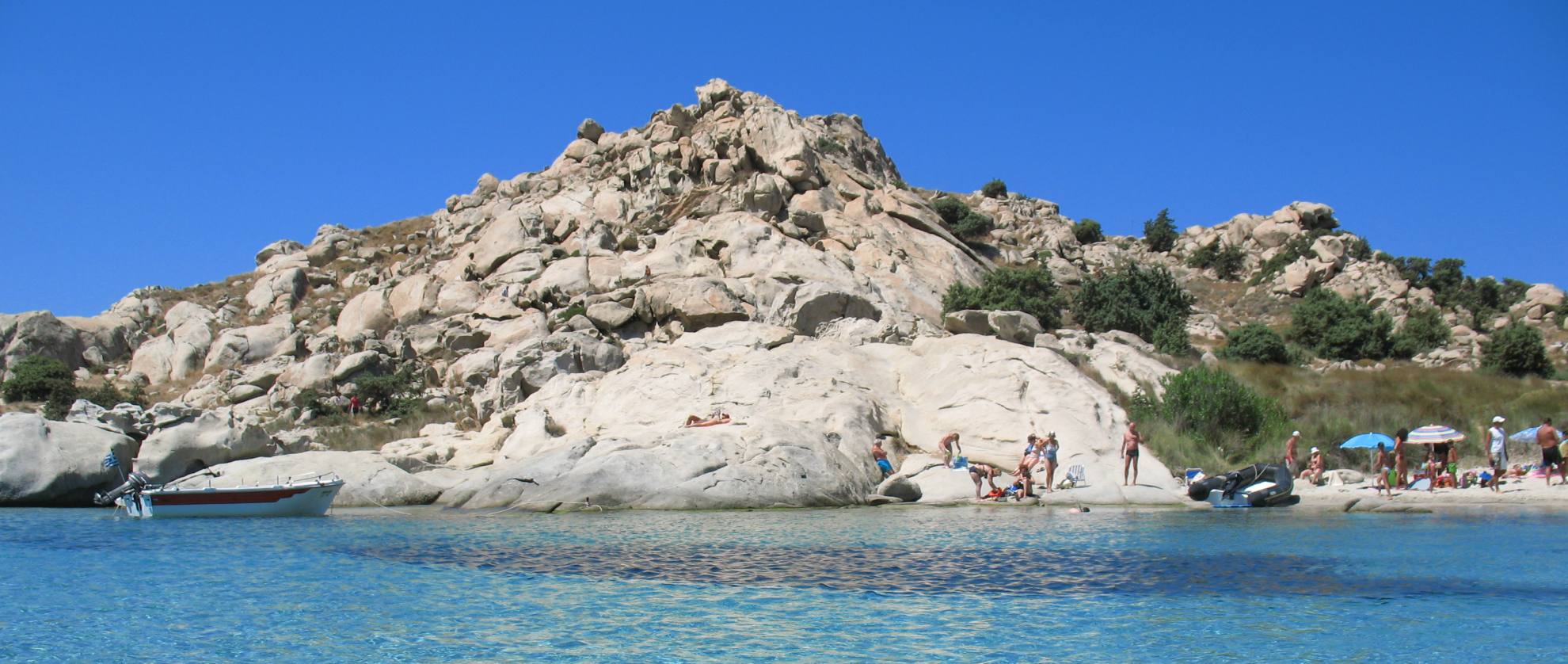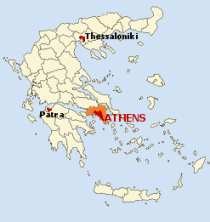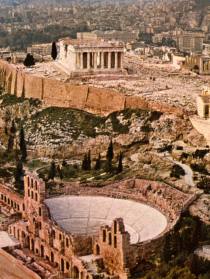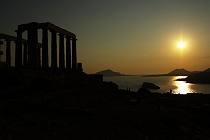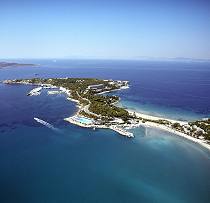Athens » Museums
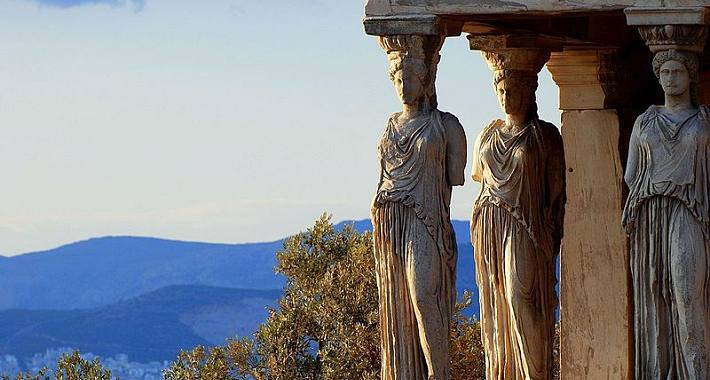
More about Athens & Attica
AthensAncient Athens
Ancient Agora
Museums
Walks in Athens
Plaka
Syntagma area
Lycabettus
Entertainment
Nightlife
Shopping
Excursions
Athenian Riviera
Mount Parnitha
Kaisariani Monastery
Daphni Monastery
Marathon
Piraeus
Porto Germeno (Aegosthena)
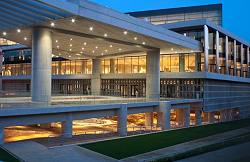
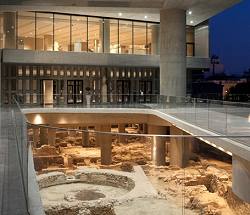
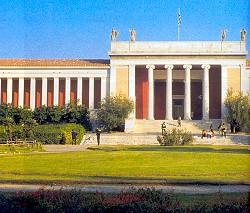
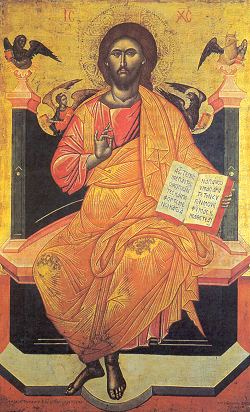
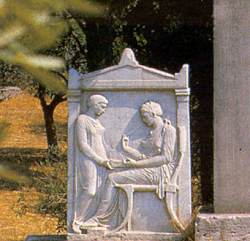
3rd - National Archaeological Museum
4th - Byzantine Museum
5th - Keramikos
The Acropolis Museum
The Acropolis Museum houses priceless finds. If you visit the
Museum prior to your walk around the site you will be able
to better understand the history and function of the Acropolis,
as the most important religious centre of the city of Athens
and thus enjoy it even more.
Important exhibits
The Moschoforos (The calf bearer) -
An exceptionally fine statue of a
bearded youth of the 6th century
B.C., carrying a calf on his
shoulders, gift to the goddess
The Kores -
The Archaic Kores were statues of
young women, offered to Athena
over a long period of time.
No Kore is similar to
another. The difference in
the way their hair is set and
their dresses pleated, offer
one a chance to admire the
evolution of the art of
sculpture in ancient Greece.
Sculptures from the decoration of Parthenon -
(444-432 BC)
These are the few remains
of the masterpiece of all
time. See, among them,
a few slabs from the frieze
depicting the Olympian
gods, a few metopes
depicting a scene from the
Centauromachia and so on.
The Caryatis -
These statues of beautiful
priestesses, were used to
support the roof of the
south porch of the
Erechtheion (420 B.C.).
They were probably named
after the women of Caryes
(an ancient city in Arcadia,
Peloponnese), who were
supposed to be the models
for the statues.
During the Turkish occupation
the Caryatids were called Petrified
Princesses or Girls of the Castle.
Tradition says that when Lord
Elgin "abducted" one of the
Caryatids, together with the other
sculptures from the Parthenon,
the remaining five used to weep
every night for the loss of their
sister. Crying or not, they are
magnificent, unique and
unforgettable.
The ancient Kerameikos was on
the north-west fringes of ancient
Athens and extended both inside
and outside the walls which now
traverse the site of the
excavations. In the centre of the
site, very close to each other, can
be seen the two most famous
gates of ancient Athens, the
Dipylon and the Sacred Gate. The
area around these gates was the
most ancient and largest cemetery
known in Attica. It was also the
burial site of the citizens honoured
by the city of Athens. Kerameikos,
according to the traveller Pausanias,
was named after Keramos, a hero
of the deme of Kerameis. But most
probably the name is due to
a settlement of potters on the
banks of the Eridanos river.
(Kerameikos: ceramic or having
to do with ceramics or ceramists).
The ancient demos of Kerameikos
included an area much larger than
the one excavated. It is believed
that it streched from the north-
west limits of the Agora to the
grove named after the hero Academos.
National Archaeological Museum
The National Archaeological
Museum is one of the largest
and most important
museums of ancient Greek
art. Its numerous
and very important exhibits
will give you the chance
for a journey into the depths
of history. You will certainly
find its riches fascinating
and indeed, to do the museum
justice, you should visit it
several times. If you intend
to visit only once, make sure
you have ample time at your
disposal. The following
is by no means intended
to be a detailed guide to the
museum. Such an account
would demand more space
than we have at our disposal
here. Just a few of the
Museum's most important
exhibits are mentioned below.
The Poseidon of Artemision -
Is it a statue of Poseidon or Zeus?
The archaeologists still argue
about it. The bronze statue, one
Iof the masterpieces of Classical
sculpture, was found in 1928, in
the wreckage of a ship off cape
Arlemision. Its height is 2.09m and
it is one of the few original bronze
statues that survive.
The statuette of Zeus -
This is a statuette of Keravnovolos
Zeus from Dodoni. Notice the
god's posture as he prepares to
launch his thunderbolts. It is the
same as that of the Poseidon
of Artemision.
Demeter and Persephone
This beautiful and well preserved
relief from Eleusis, which was
sculpted circa 440-430 BC,
depicts Demeter presenting
Tripto/emos, the young King of
Eleusis, with ears of wheat. Her
daughter Persephone, on the right,
is giving her blessing. Notice the
difference in size of Triptolemos
and Demeter. In fact it was
common practice that when gods
and people were depicted
together on a stele, the gods were
represented much taller,
as a token of respect.
The Lekythos of Myrrine -
It is the main exhibit of room 16
which was named after it. This
lekythos, made of white marble,
was found in Syntagma Square
in 1873. It is decorated with a relief
showing Hermes leading by the
hand the young woman Myrrine.
As is written above her head, the
god's intention is to deliver her
to Plouton (the god of Ades). The
scene is witnessed by three of
Myrrine's male relatives. Notice
Myrrine's bent head and the sad
look on her face (430-420 BC).
The stele of Hegeso -
Do not fail to see the most famous
of the stelae (5th century BC).
It was found in Kerameikos, where
its replica can be seen today.
The relief shows Hegeso seated,
taking a jewel out of a box that
her female slave is holding.
It is believed that the background
of the relief and the jewel were
painted blue and gold
respectively. At the top of
the stele, her name is engraved:
"Hegeso Proxeno". The skill with
which the melancholy expression
on Hegeso's face and the folds
of her dress are depicted is
beyond description.
The Jockey-Boy" of Artemission -
This bronze statue of the 2nd
century B.C. was found with the
statue of Poseidon, off cape
Artemision. It is possible that the
"Jockey-boy" and his horse were
cast separately. Notice the
superbly depicted tension of the
horse's muscles and the "Jockey
boy's" anxious expression.
Demeter, Persephone and Asklepios -
Persephone stands on the left
holding two torches in her right
hand. In front of her, seated, is
Demeter and to her right stands
Asklepios. Six suppliants can be
seen on the right. As the inscription
tells you, five of them dedicated
this relief to Asklepios and the
two Eleusinian deities. Their names
are written at the bottom of the
relief, inside crowns made of olive
branches, since they were famous
doctors crowned by the state for
their services.
The head of Hygeia -
You are undoubtedly familiar with
the head of Hygeia (Goddess
of Health) seen in thousands of
photographs. Now you have the
chance to admire her expression of
gentleness at close quarters. It was
found in the temple of Alea Athena
in Tegea and was possibly part
of a statue (350-340 BC).
The Ephebe of Antikythera -
(Ephebe: adolescent)
One more statue that has been .
an item of controversy among
archaeologists. Since it is evident
that he was holding some spherical
object in his right hand, some say ,~.
that it depicts Paris holding the ;"'
apple and others that it is a statue
of Perseus holding Andromeda's
head (340 BC). It was found
in a ship wreckage near
Antikythera in 1900.
The boy of Marathon -
This statue of a teenager was
named after the bay of Marathon
where it was unearthed in 1926.
The sign on the statue's pedestal
refers to it as one of a wrestler.
With the exception of the left arm,
which is thought to be a later
repair, the statue is considered
to be a masterpiece. It is probably
the work of Praxiteles or one
of his students (330 BC).
The golden mask of Agamemnon -
Although it has been proved not
to be the mask of Agamemnon,
it remains an exhibit worth seeing.
Schlieman's theory was wrong
and it is now thought to be the
death mask of a King who died
three centuries before Agamemnon
(16th century BC). You can see
the mask in the Hall of Mycenaean
Antiquities, which is right opposite
the entrance hall, together
with other items Gewellery, gold
artifacts, swords and so on),
found in the royal tombs of
Mycenae.
The National Gallery
It is the biggest picture and
portrait gallery in the country.
The nucleus of the National
Gallery collection, consisting of
117 paintings, was catalogued in
1878. It was later enriched by the
donation of the private collections
of Alexandros Soutzos, Euripides
Koutlides and many other Greek
painters and collectors. A number
of important works of art, as is the
"Crucifixion" by Lorenzo Veneziano
and a collection of engravings of
the 16th to 20th centuries, were
purchased by the Gallery itself.
Make sure you'll see:
"The Kiss" by N. Lytras,
"The Engagement" by N. Gyzis
"The Concert of the Angels"
by Dominikos Theotokopoulos
"The Greek Rider" by Delacroix.
The Museum of the City of Athens
Since its opening in 1980, this
Museum has been housed in the
former mansion of Stamatios
Vouros, which was also used as a
temporary palace for King Otto
between 1836 and 1842. Here,
you will find paintings and
engravings related to the history of
the Greek capital, mainly from the
beginning of the 18th and the 20th
centuries. Also on exhibit are
pieces of furniture which belonged
to the first King of Greece, Otto.
If you are an art lover make a
note to visit the A' Cemetery of
Athens. Works of some of the most
important modern Greek sculptors
are found in it. The cemetery is
renowned for the artistry of its
tombs and sculptures.
The Historical and Ethnological Museum
You will find the entrance of this
Museum just behind the
impressive statue of Kolokotronis
(hero of the Greek War of
Independence), on Stadiou Street,
very near Syntagma Square.
The building in which the Museum
has been housed since 1961 was
originally the seat of the Greek
Parliament and is, therefore,
also known as Palaia Vouli (Old
Parliament). The exhibits in the
Museum's 16 rooms cover all
the periods of modern Greek
history, from the 15th century
AD until today.
The Theatrical Museum
It is housed in the ground floor of
the Municipal Cultural Centre of
Athens. You will learn a lot about
the history of the Greek theatre
here through the photographs,
playbills, settings and masks used
in modern stagings of ancient
dramas. Costumes and persQnal
items of great Greek actors are
also on display in this Museum.
The Vorres Museum
Six thousand exhibits, reminders of
4,000 years of Greek history, are
sheltered in the 4.5 acres of this
Museum, which is actually
separated into two different
sections. In the first, you can see a
collection of contemporary Greek
art consisting of paintings and
sculptures, all works of the 2nd
half of this century. The other
section of the Museum is housed
in a complex of two traditional
village houses and a building
which was once used for wine
pressing. Here you will have
the chance to see daily life items:
carpets, furniture, millstones and
pottery pieces from various areas
in Greece. Oil paintings and
engravings related to historical
events, as well as some
archaeological finds, are also on
exhibit in this part of the Museum.
Kerameikos Museum
It is a small square building around a courtyard which you are advised to visit after your walk around the site. The main exhibits are grave offerings found inside the tombs while the entrance is dominated by funerary stelae.
Goulandris Museum of Natural History
In this very important Museum, you will have the chance to learn a lot about the interdependence of all living things. The Museum exhibits rich collections of insects, mammals, reptiles, birds and shells, as well as rocks and fossils from all over Greece. It also organises seminars, lectures and temporary exhibitions relative to crucial environmental issues in Greece and the world.
Greek Folk Art Museum
The rich collections in this Museum cover the period from 1650 to the present. They include textiles, embroideries, costumes, silverware and puppet-theatre. Also, fold paintings, works by Theofilos Hatzimichael, wood carving and stone carving.
Gennadius Library Collections
Valuable manuscripts and books, documents, magazines, maps of the most important moments in Greek literature are here. There is also a Byzantine library, a reading room, and an exhibition room. Make sure to see the collection of Lord Byron's personal items (golden watch, his laurel wreath, seals etc).
The Byzantine Museum
This Museum can justifiably be proud of one of the richest collections of Byzantine icons in the world. The building housing it was once the town residence of the Duchesse de Plaisance. The building facing the entrance houses three different churches of different periods: Early Christian, Byzantine and post-Byzantine.
The Museum of Cycladic Art
This very well organised Museum was founded to house the Goulandris' private collection of Cycladic art. On the first floor you will find various examples of the Cycladic culture, while the second floor houses miniatures and memorabilia from the same period. In 1992 a new wing was added to the Museum, which is housed in the Stathatos Mansion. In it you can see the Athens Academy's collection of ancient Greek art. On the ground floor of the Neofytou Douka Street building, you can buy replicas of the Museum's exhibits.
The War Museum
It houses weapons from the Stone Age and the Classical period to the Second World War. Also on exhibit are various types of fighter- aircraft, maps, banners, military uniforms and models of warships and fighter-planes covering the whole span of Greek history.
More about Athens & Attica
Walks in Athens » Plaka • Syntagma area • Lycabettus
Entertainment » Nightlife • Shopping
Excursions » Athenian Riviera • Mount Parnitha • Kaisariani Monastery • Daphni Monastery • Marathon • Piraeus • Porto Germeno (Aegosthena)
